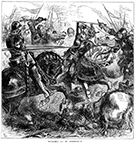
In Shakespeare's famous play, Richard III is a clever and ruthless murderer obsessed with ascending to the throne of England. History books now paint a more balanced picture of a king who brought important reforms which benefited the common people. What we didn't know until now was the location of his dead body.
After playing a central role in having Edward V declared illegitimate before claiming the crown for himself, Richard III met Henry Tudor, whose claim to the throne was supported by allies of Edward V, in the Battle of Bosworth Field. During the battle, Richard was surrounded and killed. Here the story gets murky, with some accounts of his body being thrown into a river and others suggesting a quick and un-kingly burial in Leicester.
Cut to 2012, to a team interested in finding Richard's remains. Using historical accounts indicating that he may have been buried at the Church of the Grey Friars, they keyed in on a parking lot. Next, they used ground penetrating radar in the area where the ancient church choir would have been and found human remains.
The skeleton clearly shows a man who suffered from a curved spine called scoliosis, which Richard did. Plus, wounds on the skull match descriptions of the king being struck during a cavalry charge that pushed the helmet into his skull. It's also possible he lost his helmet and was struck in the back of the head.
The comparison of mitochondrial DNA, which is always inherited from the mother, to a modern descendant of the king also proved to be a match, leaving little doubt the remains belong to King Richard III.
What's interesting is a 3D mapping of the skull has given us the first forensic reconstruction of how he appeared when he died at the age of thirty-two. And now, after all these years, there are plans to give the king a proper burial.
More Information
The Real Richard III
3-D reconstruction and linguistic research reveal English king's face, voice
The Discovery of Richard III
Fascinating background on the search for, and the discovery and identification of, the remains of the last king of the Plantagenet dynasty - also the last English king to die in battle
Plans for Richard III's final resting place announced
The reinterment of Richard III's remains is planned for Spring 2015
Computerised 3D facial reconstruction
An article on the process by Dr. Martin Evison of the University of Sheffield in the UK